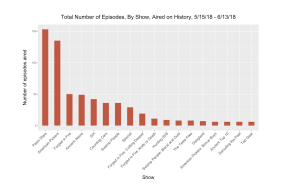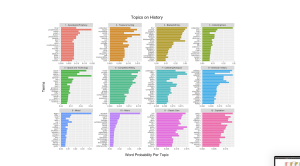For this week’s blog post, I will be looking into D.H more critically in order to trace purpose, funding, and other contributing factors that result in the collaborative effort. My focus for this project is the Digital Project by Joshua Catalano from Clemson University and Briana Pocratsky from George Mason University whose background in the respective anthropology&sociology and history departments recommend a more structured interdisciplinary angle in tackling their question on the formerly known History Channel. This project was published in October of 2020 through the CRDH (Current Research in Digital History) which is an open access journal that actively engages in peer review.
https://doi.org/10.31835/crdh.2020.02
In their project funded by the Roy Rosenweig Center for History and New Media, Catalano and Pocratsky argue that the channel’s shift from reputable historical content into conspiratorial programming signals a broader aim by the network to engage in reality television for a specified demographic. Their findings conclude that the network reproduces the theme of masculinity through praising capitalism, industrial labor and patriotism in programs such as Pawn Stars, Ancient Aliens and Counting Cars.

Thought a 30 day period from May 15, 2018 to June 13, 2018, Catalano and Pocratsky were able to apply the methodologies of distant reading and textual analysis on over 905 programs to create 12 distinct topic models that rely on word frequencies. Although the authors do not explicitly mention the programming used to generate such word corpuses, it can be assumed that they probably used Bookworm or Voyant because I doubt any sane individual would generate their own dataset on the History Channel and run it through such a cumbersome program like Mallet (but who knows right?)
Through the visual aid of bar graphs which are effective for these comparative topics, it is clear that the History Channel’s focus centers around the core themes of
- Apocalyptic/Prophecy
- Treasure hunting
- Bladesmithing
- Collecting/Cars
- Space and Technology
- Competition/Killing
- Collecting/Antiques
- American military
- Mixed
- Aliens
- Classic Cars
- Capitalism
Again, the programs used to generate such visuals is not explicitly mentioned but I can assume that one similar to Tableau was implemented. As noted in the publication, these themes are catered around a core demographic that is predominantly white, male, and older which such loosely nostalgic themes offer justification towards their world views. Unfortunately for the History channel, this shift has cost its reputation it formerly held for its historical content being supplemented through both archival research and scholarly expertise. I found this project to be quite informative as someone who grew up watching really informative documentaries and shows on the channel progressively devolve into television clickbait embodied in the “aliens” meme we’ve all come as historians to sigh depressingly into a corner (perhaps with tacos or not). Looking into the Roy Rosenweig Center for History and New Media, it appears that their funding comes in part from an endowment on behalf of George Mason University that originally was given from the National Endowment for the Humanities. Being the case, it seems that the program’s development and funding was not biased thus not motivated by any particular angle other than curiosity to examine and academically cast down what was once a great cable network. Incorporating the lessons learned from the Rubin article assigned for the week, the visualizations used by Catalano and Pocratsky help to better illustrate the relationship between power and place (the power of the History Channel to pull in viewers via cable). In conclusion, this publication informatively sheds light on market and profit driven efforts by the History channel to produce reality television under the guise of historical content.
